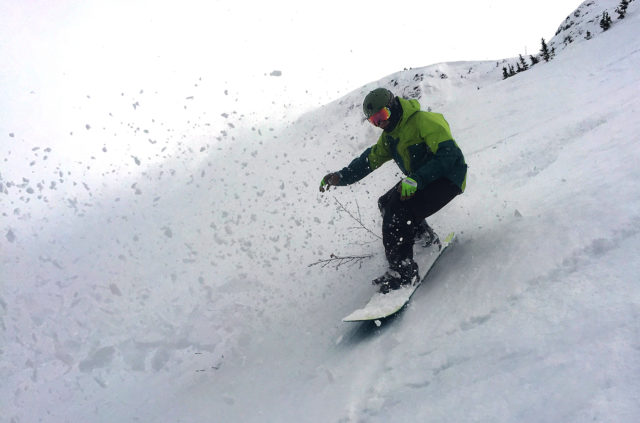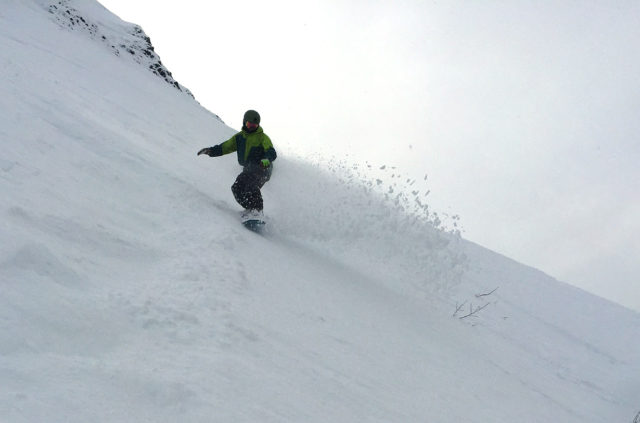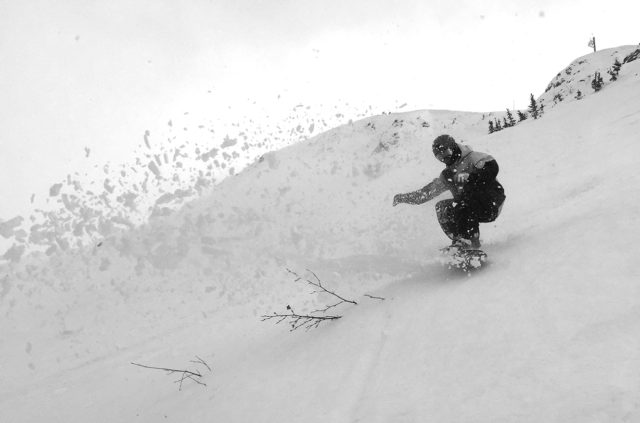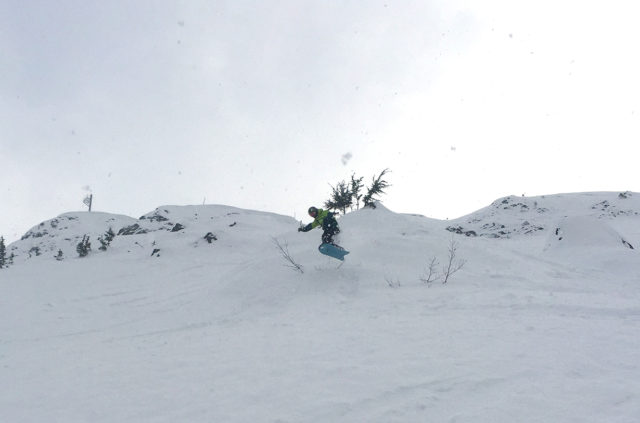Board: 2020-2021 Amplid Snommelier, 166 cm
Available Size: 166 cm
Stated Weight: ~3000 grams
Blister Measured Weight: 3080 grams / 6.8 lb
Stated Dimensions: 323-262-292 mm
Stated Sidecut Radius: 9.25 meters
Rocker Profile: rocker / camber / flat
Stated Flex Rating: 7/10
Core Construction: poplar/paulownia + carbon stringers + paper honeycomb tip/tail + fiberglass laminate
Base: Sintered 7
Boots: Vans Infuse, K2 Ender, K2 Aspect
Bindings: Union Ultra, Now O-Drive, Union Contact Pro
Test Locations: Alyeska Resort, Turnagain Pass, & Thompson Pass, AK
Days Tested: 25+
[Note: Our review was conducted on the 19/20 Snommelier, which was not changed for 20/21.]

Intro
The Snommelier is one of three boards in Amplid’s “Future Shapes” collection, which Amplid describes like this:
“Peter’s [Amplid Founder] most bonkers board concepts, Amplid’s Future Shapes snowboard family snubs the last 40 years of snowboard know-how in a bid to bring fresh ideas to the fore. Experimental by design, these colourful rogues are not just different for the sake of it: each board’s dimensions are artfully curved and skillfully balanced to create a unique personality.”
The collection consists of the Aloha Vibes, Dada, and Snommelier. The Snommelier is designed as the hard-charging, high-speed, big-mountain board of the collection, whereas the Aloha Vibes and Dada are stubbier, more playful models. The Aloha Vibes features a similar shape (somewhere between the Snommelier and Surfari) in a much more compact build, whereas the Dada is a semi-symmetrical freestyle shape. All of the Future Shapes boards are supposed to be high volume and offer excellent flotation in deep snow.
Amplid has produced some of my favorite splitboards, so I was excited to see how their solid boards rode. After spending a good chunk of time on the Snommelier last season, I’d say it certainly lives up to Amplid’s claims about it having a “unique personality.”
Weight and Construction
One of the most notable qualities of all Amplid snowboards I’ve used is the construction, both in terms of the materials used and craftsmanship. In all of the Amplid boards I’ve used (including the Snommelier), that translates to a very lightweight, snappy product.

At 3080 grams, the Snommelier is quite light (especially for a 166 cm). This is due in part to Amplid’s Omni core, which consists of a lightweight poplar / paulownia mix. In addition to its light wood core, the Snommelier features Amplid’s Hexo2 Lite construction, which further reduces the weight of the board by using recycled paper honeycomb inserts in six panels along the nose. Amplid uses this construction to reduce weight in the heftier parts of boards and consequently reduce swing weight, and we haven’t had any issues with durability after spending a lot of time on their UNW8 board (which also uses the Hexo2 Lite construction). To top it off, a band of unidirectional carbon stringers runs down the middle of the Snommelier to increase pop. The core altogether feels very well matched for the shape — supportive, yet snappy and lively enough to roost turns and stomp landings.
Similar to the Amplid Milligram and Millsurf, the Snommelier has pre-cured composite impact plates under the binding mounts, which is a feature I have come to love, especially on splitboards. Essentially, it’s an extra composite layer that helps prevent binding damage. I feel it’s more important on splitboards due to the nature of splitboard bindings’ metal baseplates and the constant transitioning, but I think it’s a nice touch on any board. To further help with durability, the Snommelier features a full-wrap metal edge, even around the entire swallowtail.
Shape
The shape of the Snomelier is what really sets this board apart from the rest. A hybrid of new and old shaping styles, the Snomelier features a long, classic swallowtail that’s coupled with a more modern, blunted nose. While all of the Future Shapes boards offer high-volume shapes for the deepest of days, the shape of the Snommelier looks to be the fastest, most freeride-specific of the 3 boards in that collection — ideal for deep snow and high-alpine riding.
Two features of the Snommelier really stand out to me: (1) the long, voluminous nose, and (2) a sidecut that feels quite long on snow. Dimensionally speaking, the Snommelier and the Weston Japow (review coming soon) share many similarities. But in deep snow, the Snommelier feels considerably faster than the Japow, Venture Euphoria, and stubbier swallowtail boards we’ve used such as the Rossignol Sushi and K2 Cool Bean. While the nose of the Snommelier isn’t as wide as the noses on those stubbier shapes, the Snommelier’s float feels comparable due to its additional length and much faster feel in deep snow. The Snommelier’s deep rocker line in the nose and fairly low tip splay does an excellent job of both penetrating and planing above the snow without feeling excessively draggy or plow-like.

The Snommelier’s 9.25 m stated sidecut radius feels like a perfect match for the size of the board — great for making long, powerful turns, slashes, and promoting confidence at higher speeds. While the Snommelier is an absolute blast to ride in moderately open terrain, shorter boards like the Japow, Sushi, Coolbean, and Prior Legacy seem much better suited to riding tighter terrain, since they feel considerably surfier and more maneuverable at slower speeds. That being said, the Snommelier isn’t marketed as a tight-terrain, jibby board (though the stubbier, surfier Aloha Vibes & Dada are).
Overall, the shape of the Snommelier makes for a board that’s exactly what Amplid claims it to be — a hard-charging, deep-conditions board that can lock into turns and that sprays snow into the stratosphere.
Rocker Profile
The Snommelier features Amplids “Low Rise camber w/ Early Rise” rocker profile, which consists of camber between the feet, a subtly rockered nose, and a pretty flat tail. This type of rocker profile has become a personal favorite on a variety of shapes throughout the years. The camber between the feet on the Snomellier provides great edging on most conditions, while the low-rise nose feels buoyant and fast.

I think the Snommelier’s rocker profile works well with the shape of the board — enough camber to handle firm and variable snow fairly well without losing excellent flotation and speed in powder. As I mentioned above, its subtly rockered nose does a great job keeping the tip afloat without feeling sluggish like a plow when riding through deep snow.
Flex Pattern
Amplid rates the stiffness of the Snommelier as a 7/10, which seems pretty reasonable. It is not as stiff as some of the carbon-laden boards out there (e.g., Jones Ultra Mountain Twin), but the Snommelier’s flex pattern works well for its intended use as a powder-oriented swallowtail. Compared to the Weston Japow, the Snommelier feels slightly stiffer and a touch springier / snappier. I will delve into more detail in the performance section, but the flex of the Snommelier is pretty ideal for deep powder; it feels very lively in bottomless pow, helping it porpoise between loaded carves, yet has enough stiffness to blast through soft tracks at very high speeds.
Powder and Soft Chop
The Snommelier is an absolute destroyer of deep snow in open and flowy terrain. Its flotation and ability to link powerful turns are exceptional, and this board seems to thrive on days when there’s at least 6-8” of powder. On more than one occasion, the Snommelier’s ability to blast snow in the air has both been detrimental to my vision and exhilarating while spending time in the white room.
One of the most notable attributes of the Snommelier is speed. This board is exceptionally fast — perhaps one of the fastest powder-specific shapes I have ridden. As mentioned above, it is not as maneuverable in tighter terrain as its shorter competitors, but the Snommelier’s ability to surf the surface of the snow with relatively little drag is very impressive. The Snommelier feels a bit unwieldy while going slow in technical terrain, whereas the Japow, Cool Bean, and Sushi pivot easily under the front foot regardless of speed. But once you get the Snommelier up to speed, it does feel responsive to rider input when dodging trees, hammering turns, and slashing lips.

The shape and general nature of swallowtails tend to make deep days easy on the legs, allowing you to ride longer and stronger without fatiguing your quads. The reduction of volume in the Snommelier’s tail keeps the nose up and makes for a balanced overall feel in powder. I have found that shorter boards like the Sushi and Cool Bean feel more like a plow in deep snow, with the nose high and the tail sunk deep into the snow, resulting in a slower, more sluggish ride in deep snow. The length and balanced feel of the Snommelier makes it great for charging through deep conditions — despite its large swallowtail, I found that I could ride the Snommelier very balanced / flat in deep snow.
The Snommelier’s flex and camber make it extremely lively and poppy, perfect for sending straight airs and drops. That said, the Snommelier feels pretty unwieldy and not very balanced in the air during spins (more so than the Japow), which isn’t very surprising, given its length and setback stance. So in case it isn’t clear just by looking at it, the Snommelier is not a great choice for those who prioritize freestyle performance.
The Snommelier feels stiff enough to blast through set-up wet snow and soft chop quite well, remaining fun all day when it’s snowed more than ~6”. There are definitely better boards for absolutely charging through chop, but as long as the snow is fairly soft and deep (~6”+), I didn’t feel the need to switch out to a different board when the pow got tracked out. Overall, the Snommelier is an excellent choice for the deepest days of the year.

I have found that stiffer bindings such as the Now O-Drive and Union Ultra are great pairings for boards like the Snommelier, as they do a better job of transferring power to the edges compared to softer bindings. I have been a fan of stiffer carbon bindings on all the stiffer and / or wider freeride boards I’ve used.
Firm and Variable Snow
While the Snommelier will do a fairly good job getting down firm and variable snow at the end of the day, it is not a great choice for generally firmer conditions; the Snommelier excels as a big board for deep days, rather than a 1-board quiver. Its ride feels rather chattery on firm snow and carving hard on it can feel sketchy when the snow is firm and rough.
I found that the Japow and Sushi are a bit more versatile than the Snommelier — those boards can be extremely fun on groomers and non-powder conditions, while the Snommelier definitely performs best in soft conditions. The more moderate shapes and sidecuts of those boards help them edge much better on firm snow and they feel considerably more damp than the Snommelier.
Corn / Spring Conditions
Riding near sea level at Alyeska Resort meant that I spent plenty of time riding through wet pow and spring conditions. As long as the snow is soft and at least ~6-8” deep, the Snommelier is a really fun board.
Riding variable conditions (mix of hard & soft snow) on the Snommelier proved to be a bit more challenging. Once again, boards like the Japow, Cool Bean, Sushi, Chimera Unicorn Chaser, and Venture Euphoria seem to do better jobs when it comes to edging and blasting through variable soft or hard snow.
Who’s It For?
The Snommelier excels on the deepest days of the year and would make for a superb addition to any intermediate to expert rider’s quiver. Its shape is remarkably fast and great for making the most of a powder day. While the beauty of the board is how well it carves and slashes in soft snow, the Snommelier is snappy enough to encourage airs and drops all over the mountain (though it’s not great for spins). There are lots of shorter, more nimble boards that perform better in super tight terrain, but the Snommelier is a very capable big-mountain gun that’s perfect for relatively open terrain and big faces.
There are more versatile powder-specific shapes out there (such as the Japow), but the Snommelier is unrivaled in its ability to charge through deep snow at high speeds (and roost massive powder clouds).
Bottom Line
The Amplid Snommelier’s blend of a vintage swallowtail, long length, and modern construction makes for a board that excels in deep snow and at high speeds. Sleek, fast, and floaty, the Snommelier is a ton of fun in pow and is one of the best powder-oriented boards we’ve used when it comes to making fast, powerful turns in wide-open, pow-filled terrain. If you’re looking to add a soft-snow board to your quiver and you prioritize speed, float, and power, the Snommelier is an excellent choice.

Thanks for the great review. Have you tried the jones lone wolf by chance? Im split between purchasing this board and that one. I am looking for a board to ride on the deepest coastal days in north west BC. I need a board that can get me up on top of the pow,stay at speed and keep speed through the flats. On these days none of my other boards cut it as I just cant get moving fast enough. I currently have a mind expander 158, flagship161, hover craft 160, and a solution 161. I got the hover craft for the deep days and I got it longer than recommended but I would still like some thing bigger and faster also I found because of the width of the hover craft that its hard on my body when riding pillows and airs upon landing as apposed to my tapered mind expander or flagship. Ive found that a tapered board works better for scrubbing speed of deep pillows take offs where I just want to creep to hit the lower pillows. An ideal board for me would be something that gets on plane and keeps speed through the deeper flatter pow for insanely deep powder days and still allows me to hit cliffs and pillows if I can get to them.
Thanks for all your great reviews!
Cam